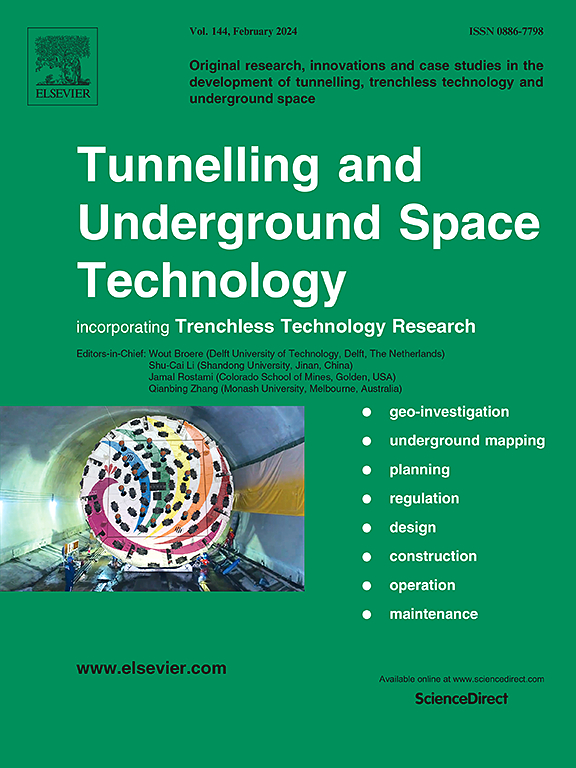A novel flexible joint mechanical model and application in semi-analytical solution for longitudinal response of tunnel subjected to fault movement
IF 6.7
1区 工程技术
Q1 CONSTRUCTION & BUILDING TECHNOLOGY
引用次数: 0
Abstract
The flexible joints and segmental lining serve as effective seismic measures for tunnel in high-intensity seismic area. However, the tunnel axial deformation at flexible joints has not been fully incorporated into analytical models. This study presents a novel mechanical model for flexible joints that considers tension (compression)-shear- rotation deformations, replacing the traditional shear-rotation springs model. An improved semi-analytical solution has been developed for the longitudinal response of a tunnel featuring a three-way flexible joint mechanical model subjected to fault movement. The nonlinear elastic–plastic foundation spring, the soil-lining tangential interaction, and the axial force of tunnel lining have been considered to improve the applicability and precision of proposed method. The proposed solution is compared with existing models, such as short beams connected by shear and rotation springs, by examining the predictions against numerical simulations. The results indicate that the predictions of the proposed model align much more closely with the outcomes of the numerical simulations than those of the existing models. For the working conditions selected in section 4, neglecting the tension–compression deformation at flexible joints an 81.8% error in the peak axial force of the tunnel and a 20.2% error in the peak bending moment. The reason is that ignoring the axial deformation of these joints results in a larger calculated axial force on the lining, which subsequently leads to increased bending moment and shear force. Finally, a parameter sensitivity analysis is conducted to investigate the effect of various factors, including flexible joint stiffness, segmental lining length, and the length of the tunnel fortification zone.
一种新的柔性接头力学模型及其在断层运动下隧道纵向响应半解析解中的应用
柔性缝和节段衬砌是高烈度地震区隧道的有效抗震措施。然而,隧道在柔性节理处的轴向变形尚未完全纳入分析模型。本文提出了一种考虑拉(压)-剪切-旋转变形的柔性关节力学模型,取代了传统的剪切-旋转弹簧模型。本文提出了断层运动下具有三向柔性接头力学模型的隧道纵向响应的改进半解析解。考虑了非线性弹塑性地基弹簧、土-衬砌切向相互作用和隧道衬砌轴向力等因素,提高了方法的适用性和精度。通过对数值模拟的检验,将提出的解决方案与现有的模型(如由剪切和旋转弹簧连接的短梁)进行比较。结果表明,与现有模型相比,该模型的预测结果与数值模拟结果更加接近。对于第4节所选工况,忽略柔性节点的拉压变形,隧道轴向力峰值误差为81.8%,弯矩峰值误差为20.2%。原因是忽略这些节理的轴向变形会导致计算得到的衬砌轴向力较大,从而导致弯矩和剪力增大。最后,对柔性节点刚度、管片衬砌长度、隧道设防区长度等因素的影响进行了参数敏感性分析。
本文章由计算机程序翻译,如有差异,请以英文原文为准。
求助全文
约1分钟内获得全文
求助全文
来源期刊

Tunnelling and Underground Space Technology
工程技术-工程:土木
CiteScore
11.90
自引率
18.80%
发文量
454
审稿时长
10.8 months
期刊介绍:
Tunnelling and Underground Space Technology is an international journal which publishes authoritative articles encompassing the development of innovative uses of underground space and the results of high quality research into improved, more cost-effective techniques for the planning, geo-investigation, design, construction, operation and maintenance of underground and earth-sheltered structures. The journal provides an effective vehicle for the improved worldwide exchange of information on developments in underground technology - and the experience gained from its use - and is strongly committed to publishing papers on the interdisciplinary aspects of creating, planning, and regulating underground space.
 求助内容:
求助内容: 应助结果提醒方式:
应助结果提醒方式:


